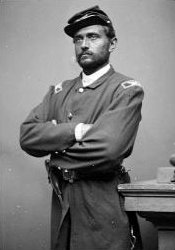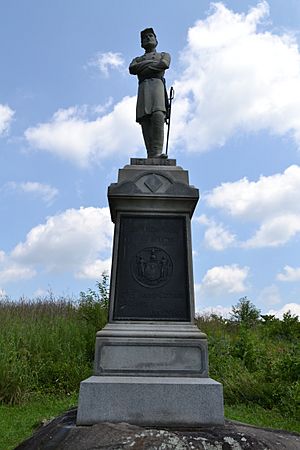Augustus van Horne Ellis facts for kids
Quick facts for kids
Augustus van Horne Ellis
|
|
|---|---|
 |
|
| Born | May 1, 1827 New York City, New York, U.S. |
| Died | July 2, 1863 (aged 36) Gettysburg, Pennsylvania, U.S. |
| Buried | |
| Allegiance | Kingdom of Hawaii United States |
| Service/ |
Hawaiian Navy Union Army |
| Years of service | 1861–1863 |
| Rank | |
| Unit | 71st New York State Militia 56th New York Volunteer Infantry |
| Commands held | 124th New York Volunteer Infantry Regiment |
| Battles/wars | American Civil War |
Augustus van Horne Ellis (born May 1, 1827 – died July 2, 1863) was an American lawyer, sea captain, and soldier. He served as a colonel in the Union Army during the Civil War. He was sadly killed in action during the famous Battle of Gettysburg.
Contents
Augustus Ellis's Early Life and Adventures
Augustus V. H. Ellis was born in New York City. He went to public schools there and later studied at Columbia University. Before the Civil War, he worked as a lawyer in New York City.
He later moved to California. There, he worked as a tax commissioner and a fireman. He also became a sea captain, which meant he commanded ships.
Ellis even traveled to the Kingdom of Hawaii. He became friends with the king of the islands, Kamehameha III. The king made Ellis the head of the Hawaiian Navy! However, Ellis found out there were no warships in the navy. So, he returned to California and became a captain of a steamship.
Serving in the Civil War
When the Civil War started, Ellis was living in New Windsor, New York. He joined the 71st New York State Militia as a captain. His group went to Washington, D.C. to join the Union Army.
Ellis fought in his first battle at the First Battle of Bull Run. Later, he helped train another group of soldiers, the 56th New York Volunteer Infantry. On September 5, 1862, Ellis became the first colonel of the new 124th New York Infantry. This regiment was mostly made up of men from Orange County. After training, they joined the main Union army, called the Army of the Potomac.
The "Orange Blossoms" at Chancellorsville
Ellis and his men faced heavy fighting in May 1863. This was at the Battle of Chancellorsville. Here, Ellis gave the 124th Regiment their famous nickname: the "Orange Blossoms." He told his soldiers, "Let the girls of old Orange hear a good report of this day's work." The regiment lost many soldiers in this battle. About 40% of their men were killed or wounded.
The Battle of Gettysburg
Just a month after Chancellorsville, the 124th Regiment marched north. They were heading towards Gettysburg. On the second day of the battle, July 2, 1863, they were positioned on Houck's Ridge. This area was near the large rocks of Devil's Den.
Because of their losses at Chancellorsville, the 124th had only 18 officers and 220 men. They faced a strong attack from Confederate soldiers. Colonel Ellis and his officers stayed on their horses during the fight. An officer worried about this, but Ellis's major, James Cromwell, said, "The men must see us today." This quote later became the title of a painting about the battle.
Ellis was very brave during the fighting. He stayed on his horse, with his sword drawn. He encouraged his men to keep fighting even in the chaos. Sadly, during the intense battle, a bullet hit Ellis in the forehead. He fell dead from his horse.
In the fight for that area, the 124th New York lost many men. Ellis's body was taken back to New York City. He was buried in Manhattan at St. Mark's Church in-the-Bowery. His burial spot was unknown for many years. In 2007, researchers finally found it using old church records.
Remembering Colonel Ellis
After the war, people from Orange County raised money. They built a monument for the 124th Regiment at Gettysburg. It was dedicated on July 2, 1884. This was the first monument for a New York regiment on the battlefield.
The monument is on Houck's Ridge, where the regiment fought. It has a life-sized statue of Colonel Ellis. He stands with his arms crossed, looking calmly ahead. This is the only full-sized statue of a Union regimental commander at Gettysburg.
In 1868, the United States Army built a new fort in Montana. It was named "Fort Ellis" to honor him. The fort protected travelers on the Bozeman Trail.
A group called the Augustus van Horne Ellis Camp #124 of the Sons of Union Veterans of the Civil War in Goshen, New York, is named after him. They give a scholarship to a high school student every year.
A friend once said that Ellis was "a rather cold, harsh ambitious man... but he was every inch a soldier." This shows he was a tough but dedicated military leader.
See Also
- List of American Civil War generals (Union)


